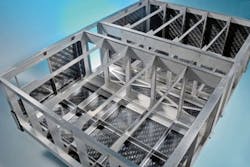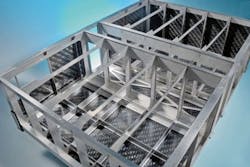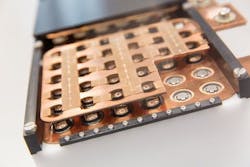Fraunhofer ILT develops laser-based process for constructing lightweight battery packs
Aachen, Germany - The Fraunhofer Institute for Laser Technology (ILT) has developed processes that significantly contribute to the reduction of CO2 emissions. For processing high-strength steel, excessive thermal influence and, thus, material damage must be avoided. So, laser cutting and welding, with a small heat-affected zone, are particularly well suited and economically more efficient than the traditional metal cutting processes, as no material wear occurs.
“This process is already being used by Volvo," explains Dr. Alexander Olowinsky. "What is new here, however, is the combination of a plastic/metal compound for use in the car body. Thanks to the connection to the plastic, less steel is required in the application. Higher strength is achieved and the battery case is lighter. Through this process, we ensure that the industry can exploit the full potential of lightweight high-strength steel."
Fraunhofer ILT has developed a laser-based process for connecting organic sheets with high-strength steel. In the two-step method, a continuously emitting fiber laser at high speed first generates a microstructure in the metal. The structures have an undercut and are 30µm wide and about 100µm deep. In the subsequent joining step, the plastic is pressed against the structure and heated up to the molten phase of the matrix material. The matrix material then flows into the microstructures and locks into the undercut structures. The resulting connection is highly robust, so an additive is unnecessary.
To construct complete battery packs, the researchers rely on oscillation welding with laser radiation. Here, individual battery cells (type 18650), which are normally used in power tools and notebooks, are welded together with copper contacts, therefore providing an electrical and thermal connection. The remarkable thing is that the joining at the negative pole also takes place from the top of the cell. In a parallel circuit of 30 cells, a tight space between the battery cells is created by the design of the module and filled with phase change material (PCM) slurry (a mixture of paraffin and water). The use of laser-beam oscillation welding leads to a better control of the welding and, thus, a stable process. Moreover, the method is qualified and suitable for industrial mass production of, for example, power tools.
For more information, please contact [email protected] or [email protected].


